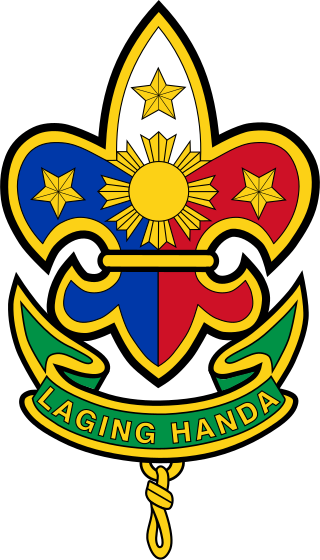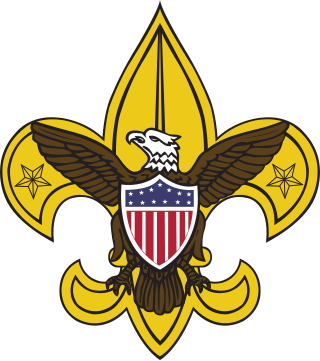
The Boy Scouts of America is one of the largest scouting organizations and one of the largest youth organizations in the United States, with about 762,000 youth participants. The BSA was founded in 1910; about 110 million Americans have participated in its programs. BSA became a founding member organization of the World Organization of the Scout Movement in 1922.
Scouting in New Jersey has a long history, from the 1910s to the present day, serving thousands of youth in programs that suit the environment in which they live. The second Boy Scouts of America National Headquarters was in North Brunswick, although it was referred to in BSA publications as being in neighboring New Brunswick.

The Boy Scouts of the Philippines (BSP) is the national scouting organization of the Philippines in the World Organization of the Scout Movement. The Scout movement was first introduced in the Philippines on 1910 during the American Occupation. It was "granted Recognition as a Member Organisation of the Boy Scouts International Conference...with effect from October 31, 1936" by virtue of certification signed by J. S. Wilson, Olave Baden-Powell, and Daniel Spry.

Cub Scouts, Cubs or Wolf Cubs are programs associated with Scouting for young children usually between 7 and 12, depending on the organization to which they belong. A participant in the program is called a Cub. A group of Cubs is called a "Pack".

Cub Scouting is part of the Scouting program of the Boy Scouts of America (BSA), available to boys and girls from kindergarten through fifth grade, or 5 to 10 years of age and their families. Its membership is the largest of the five main BSA divisions. Cub Scouting is part of the worldwide Scouting movement and aims to promote character development, citizenship training, personal fitness, and leadership.

The Greater St. Louis Area Council (GSLAC) of the Boy Scouts of America was formed in 1911 and is based in St. Louis, Missouri. The council serves Scouts in the St. Louis Metro area, southeast Missouri, and southern and central Illinois.
Woodcraft League of America, originally called the Woodcraft Indians and League of Woodcraft Indians, is a youth program, established by Ernest Thompson Seton in 1901. Despite the name, the program was created for non-Indian children. At first the group was for boys only, but later it would also include girls. Seton instructed the children in his town in Connecticut in outdoor "Woodcraft" – knowledge and skills of life in the woods – and based much of the group's terminology and structure on the misconceptions about Native Americans that were common in that era. The program spread internationally to become the Woodcraft Movement and many of these programs still exist. Seton's Woodcraft scheme also had a strong influence on later youth programs and organizations, particularly, the Scout Movement.

Edward Urner Goodman was an influential leader in the Boy Scouts of America (BSA) movement for much of the twentieth century. Goodman was the national program director from 1931 until 1951, during the organization's formative years of significant growth when the Cub Scouting and Exploring programs were established. He developed the BSA's national training center in the early 1930s and was responsible for publication of the widely read Boy Scout Handbook and other Scouting books, writing the Leaders Handbook used by Scout leaders in the United States during the 1930s and 1940s. In the 1950s, Goodman was Executive Director of Men's Work for the National Council of Churches in New York City and active in church work.
The Boy Scouts of America (BSA), one of the largest private youth organizations in the United States, has policies which prohibit those who are not willing to subscribe to the BSA's Declaration of Religious Principle, which has been interpreted by some as banning atheists, and, until January 2014, prohibited all "known or avowed homosexuals", from membership in its Scouting program. The ban on adults who are "open or avowed homosexuals" from leadership positions was lifted in July 2015.

Scouting in Puerto Rico was introduced in the 1920s, and has been serving both boys and girls in the island since then. The Boy Scouts of America (BSA), serves both boys and girls in different programs, while the Girl Scouts of the USA serves only girls in various levels.

James Edward West was a lawyer and an advocate of children's rights, who became the first professional Executive Secretary, soon renamed Chief Scout Executive, of the Boy Scouts of America (BSA), serving from 1911 to 1943. Upon his retirement from the BSA, West was given the title of Chief Scout.
Joseph A. Brunton Jr. was a career professional for the Boy Scouts of America, and served the BSA National Council as the fourth Chief Scout Executive from 1960 to 1966.

Scouts BSA is the flagship program and membership level of the Boy Scouts of America (BSA) for boys and girls between the ages of typically 11 and 17. It provides youth training in character, citizenship, and mental and personal fitness. Scouts are expected to develop personal religious values, learn the principles of American heritage and government, and acquire skills to become successful adults.
Beavers is a programme associated with some Scouting organisations generally for children aged 5/6 to 7/8 who are too young for the Cub programme.
Lone Scouts of America (LSA) was a Scouting organization for American boys that operated from 1915 until it merged with the Boy Scouts of America (BSA) in 1924. The LSA was founded by W. D. Boyce, publisher of the Chicago Ledger and the Saturday Blade and one of the founders of the BSA. Boyce felt that the program of the BSA did not help the rural boy who could not find enough other boys to form a troop or a patrol. James E. West, the first Chief Scout Executive of the BSA, disagreed with Boyce's concept, believing that the 4-H program was fulfilling the role. After Boyce left the BSA, he started the Lone Scouts of America and incorporated it on January 9, 1915. Boyce became the executive officer or Chief Totem and Frank Allan Morgan became the editor of The Lone Scout. In October 1915, Boyce appointed all of his paperboys as members of the LSA and published the first issue of The Lone Scout magazine.

The Boy Scouts of America (BSA) was inspired by and modeled on The Boy Scouts Association, established by Robert Baden-Powell in Britain in 1908. In the early 1900s, several youth organizations were active, and many became part of the BSA.

The Greater New York Councils (GNYC) is a local council of the Boy Scouts of America that serves the New York City area. GNYC has a unique organization in that it is sub-divided into borough councils, each of which is led by a borough executive. The borough councils are then divided into districts. Over five million young people have experienced Scouting through GNYC, since the council's inception in the 1920s.

The Pushmataha Area Council is part of the Boy Scouts of America. It renders service to Scout units in ten counties of North Mississippi, providing skills training and character development to boys and girls between the ages of 5 and 18. The council also serves boys and girls between the ages of 14 and 21 through Venturing Crews and Explorer posts.

Monmouth Council, BSA, established in 1917, serves all of Monmouth County, New Jersey and part of Middlesex County, New Jersey. The Council was the starting point for the landmark US Supreme Court case Boy Scouts of America v. Dale.
Youth organizations in the United States are of many different types. The largest is the government run 4-H program, followed by the federally chartered but private Scouting movement groups: the Boy Scouts of America (BSA) and the Girl Scouts of the USA (GSUSA). Another somewhat smaller but co-ed Scouting derived group is Camp Fire. Other youth groups are religious youth ministries such as the evangelical Christian Awana, Seventh-day Adventist Pathfinders, and Assemblies of God Royal Rangers.












